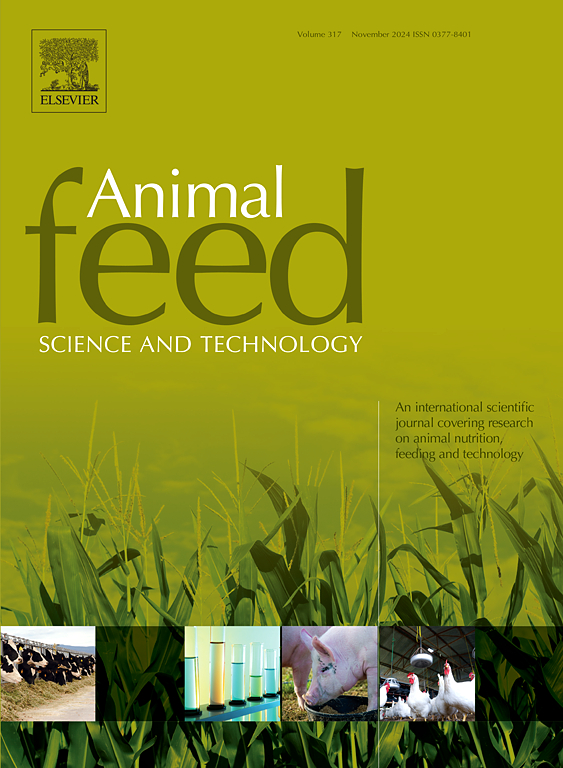Different rumen biohydrogenation extents in lambs: Assessing fatty acid composition, growth performance, carcass characteristics, and digestibility
IF 2.5
2区 农林科学
Q1 AGRICULTURE, DAIRY & ANIMAL SCIENCE
引用次数: 0
Abstract
Rumen microbial biohydrogenation is a crucial process in the ruminant digestive system. Variability in fatty acid composition of longissimus lumborum, rumen fermentation, and bacterial communities was examined between lambs categorized into low (LB) and high (HB) rumen biohydrogenation extent groups. Lambs in HB group demonstrated enhanced apparent digestibility of feed nutrients compared to LB lambs (P ≤ 0.05). Furthermore, the HB lambs displayed higher rumen tissue weight, and rumen/carcass ratio. Higher concentrations of ammonia and total VFA, but lower acetate/n-butyrate ratio in rumen of HB lambs than in the rumen of LB lambs were observed (P ≤ 0.05). Distinct rumen bacterial communities were observed between the HB and LB lambs, with the former exhibiting higher abundance of WCHB1–41_ge but lower abundance of Fibrobacter (P ≤ 0.05). No gene directly involved in biohydrogenation was detected according to the PICURSt functional prediction. Moreover, HB lambs displayed elevated relative abundance of C18:0 in their muscles (P ≤ 0.05). In conclusion, individual biohydrogenation extent in rumen is connected with rumen fermentation, fiber degradation, and meat FA profile. Rumen fermentation parameters and amplicon results confirmed a shift in fermentation mode from acetate to n-butyrate, potentially facilitated by fiber-degrading bacterium WCHB1–41_ge. The findings suggest that enhancing biohydrogenation extent could improve feed nutrient utilization and rumen function, potentially leading to better growth performance and carcass characteristics in lambs. The observed differences in rumen fermentation patterns and bacterial communities inform dietary strategies aimed at optimizing meat fatty acid profiles, which are important for both meat industry stakeholders and consumers seeking healthier meat products.
羔羊不同瘤胃生物氢化程度:评估脂肪酸组成、生长性能、胴体特性和消化率
瘤胃微生物生物氢化是反刍动物消化系统的一个重要过程。将羔羊分为低(LB)和高(HB)瘤胃生物氢化程度组,研究羔羊腰最长肌脂肪酸组成、瘤胃发酵和细菌群落的差异。HB组羔羊对饲料营养物质的表观消化率高于LB组(P ≤ 0.05)。此外,HB羔羊具有较高的瘤胃组织重和瘤胃/胴体比。HB羔羊瘤胃氨氮和总VFA浓度高于LB羔羊(P ≤ 0.05),乙酸/正丁酸比低于LB羔羊(P < 0.05)。HB和LB羔羊瘤胃细菌群落差异显著,前者WCHB1-41_ge丰度较高,而纤维杆菌丰度较低(P ≤ 0.05)。PICURSt功能预测未检测到直接参与生物加氢的基因。HB羔羊肌肉中C18:0的相对丰度升高(P ≤ 0.05)。综上所述,瘤胃内个体生物氢化程度与瘤胃发酵、纤维降解和肉FA特征有关。瘤胃发酵参数和扩增结果证实了发酵模式从醋酸盐向正丁酸盐的转变,这可能是由纤维降解细菌WCHB1-41_ge促进的。由此可见,提高生物氢化程度可以提高羔羊的饲料养分利用率和瘤胃功能,从而改善羔羊的生长性能和胴体特性。观察到的瘤胃发酵模式和细菌群落的差异为优化肉类脂肪酸结构的饮食策略提供了信息,这对肉类行业利益相关者和寻求更健康肉类产品的消费者都很重要。
本文章由计算机程序翻译,如有差异,请以英文原文为准。
求助全文
约1分钟内获得全文
求助全文
来源期刊

Animal Feed Science and Technology
农林科学-奶制品与动物科学
CiteScore
6.00
自引率
6.20%
发文量
266
审稿时长
3 months
期刊介绍:
Animal Feed Science and Technology is a unique journal publishing scientific papers of international interest focusing on animal feeds and their feeding.
Papers describing research on feed for ruminants and non-ruminants, including poultry, horses, companion animals and aquatic animals, are welcome.
The journal covers the following areas:
Nutritive value of feeds (e.g., assessment, improvement)
Methods of conserving and processing feeds that affect their nutritional value
Agronomic and climatic factors influencing the nutritive value of feeds
Utilization of feeds and the improvement of such
Metabolic, production, reproduction and health responses, as well as potential environmental impacts, of diet inputs and feed technologies (e.g., feeds, feed additives, feed components, mycotoxins)
Mathematical models relating directly to animal-feed interactions
Analytical and experimental methods for feed evaluation
Environmental impacts of feed technologies in animal production.
 求助内容:
求助内容: 应助结果提醒方式:
应助结果提醒方式:


